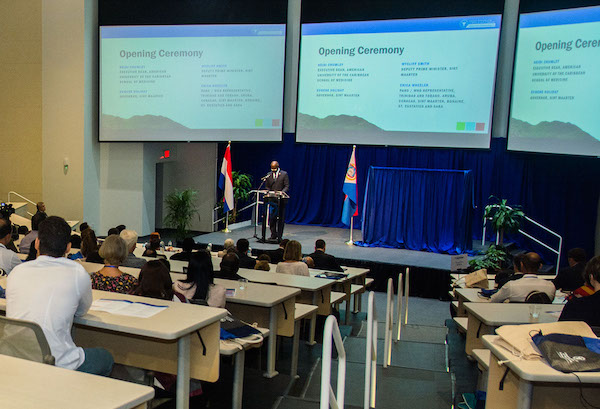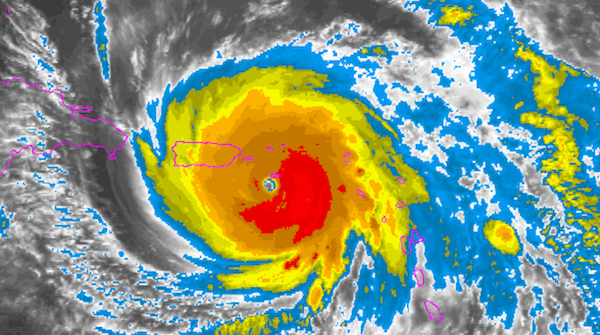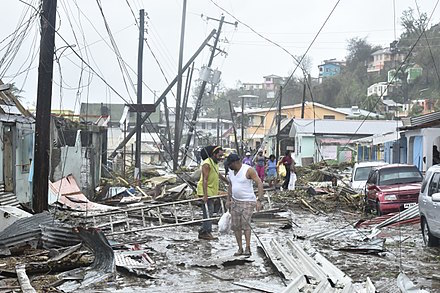 One of the most interesting twists resulting from Hurricane Maria striking Puerto Rico was Elon Musk's offer that Tesla could help Puerto Rico solve its energy crisis, with a long-term, 21st century fix. After all, its electrical grid was devastated, with almost all the power wiped out. It didn't help that even prior to this disaster its system was antiquated and badly in need of repairs. It is telling that we don't have similar offers to rebuild the Puerto Rico's health care system, which is similarly devastated. Or, for that matter, our system, which is its own kind of disaster. Mr. Musk was asked on Twitter if Tesla could help Puerto Rico using solar and battery power, and he responded in the affirmative, saying it had done so on smaller islands but faced no scalablity issues...
One of the most interesting twists resulting from Hurricane Maria striking Puerto Rico was Elon Musk's offer that Tesla could help Puerto Rico solve its energy crisis, with a long-term, 21st century fix. After all, its electrical grid was devastated, with almost all the power wiped out. It didn't help that even prior to this disaster its system was antiquated and badly in need of repairs. It is telling that we don't have similar offers to rebuild the Puerto Rico's health care system, which is similarly devastated. Or, for that matter, our system, which is its own kind of disaster. Mr. Musk was asked on Twitter if Tesla could help Puerto Rico using solar and battery power, and he responded in the affirmative, saying it had done so on smaller islands but faced no scalablity issues...
 More than two months after Hurricane Harvey submerged much of metropolitan Houston, recovery is under way across the city. Residents and volunteers are gutting and restoring flooded homes. Government agencies and nonprofit organizations are announcing cleanup programs and developing plans to distribute relief funds. But many questions remain about impacts on public health. What contaminants did floodwaters leave behind? How many people are being exposed to mold – which can grow rapidly in damp, humid conditions – as they repair their homes? Will there be an increase in Zika, West Nile or other vector-borne diseases as mosquito populations recover? Or an uptick in reported cases of other illnesses?...
More than two months after Hurricane Harvey submerged much of metropolitan Houston, recovery is under way across the city. Residents and volunteers are gutting and restoring flooded homes. Government agencies and nonprofit organizations are announcing cleanup programs and developing plans to distribute relief funds. But many questions remain about impacts on public health. What contaminants did floodwaters leave behind? How many people are being exposed to mold – which can grow rapidly in damp, humid conditions – as they repair their homes? Will there be an increase in Zika, West Nile or other vector-borne diseases as mosquito populations recover? Or an uptick in reported cases of other illnesses?...
 More than 280 healthcare professionals, emergency preparedness experts, and government leaders gathered on campus March 8-11 with the goal of uniting their collective experience and expertise to increase their communities’ ability to manage hurricanes and other disasters. Attendees represented 12 countries, including 9 Caribbean islands, and a multitude of backgrounds in disaster preparedness and response, including disaster medicine and veterinary medicine, nursing, hospital administration, mental health, telehealth, EMS and first responders, disaster recovery and humanitarian assistance, medical education, and more.
More than 280 healthcare professionals, emergency preparedness experts, and government leaders gathered on campus March 8-11 with the goal of uniting their collective experience and expertise to increase their communities’ ability to manage hurricanes and other disasters. Attendees represented 12 countries, including 9 Caribbean islands, and a multitude of backgrounds in disaster preparedness and response, including disaster medicine and veterinary medicine, nursing, hospital administration, mental health, telehealth, EMS and first responders, disaster recovery and humanitarian assistance, medical education, and more. During 2018, the U.S. experienced a very active year of weather and climate disasters. In total, the U.S. was impacted by 14 separate billion-dollar disaster events: two tropical cyclones, eight severe storms, two winter storms, drought, and wildfires. The past three years (2016-2018) have been historic, with the annual average number of billion-dollar disasters being more than double the long-term average. The number and cost of disasters are increasing over time due to a combination of increased exposure, vulnerability, and the fact the climate change is increasing the frequency of some types of extremes that lead to billion-dollar disasters.
During 2018, the U.S. experienced a very active year of weather and climate disasters. In total, the U.S. was impacted by 14 separate billion-dollar disaster events: two tropical cyclones, eight severe storms, two winter storms, drought, and wildfires. The past three years (2016-2018) have been historic, with the annual average number of billion-dollar disasters being more than double the long-term average. The number and cost of disasters are increasing over time due to a combination of increased exposure, vulnerability, and the fact the climate change is increasing the frequency of some types of extremes that lead to billion-dollar disasters. Four continental states and one U.S. territory took a beating this fall as one natural disaster after another rocked communities in Northern California and along the Gulf Coast, spreading disaster relief resources and personnel thin as federal, state, and local governments scrabbled to address the crises. Wildfires in California's wine country claimed at least 42 lives, 8,400 structures, and 245,000 acres of land in October. Hurricanes Harvey and Irma pummeled Louisiana, Texas, and Florida only to be followed by Hurricane Maria, which slammed Puerto Rico on September 20 and left much of the U.S. territory without communications systems, electricity, clean water, or functioning hospitals....
Four continental states and one U.S. territory took a beating this fall as one natural disaster after another rocked communities in Northern California and along the Gulf Coast, spreading disaster relief resources and personnel thin as federal, state, and local governments scrabbled to address the crises. Wildfires in California's wine country claimed at least 42 lives, 8,400 structures, and 245,000 acres of land in October. Hurricanes Harvey and Irma pummeled Louisiana, Texas, and Florida only to be followed by Hurricane Maria, which slammed Puerto Rico on September 20 and left much of the U.S. territory without communications systems, electricity, clean water, or functioning hospitals.... The back-to-back devastation of hurricanes Harvey, Irma and Maria, followed by catastrophic wildfires in California, overwhelmed federal disaster responders in 2017, according to a government report released Tuesday. The unprecedented sequence of storms and fires forced Federal Emergency Management Agency staff to jump from one disaster to another and in some cases use uncertified workers to fill key roles. “They were 30% understaffed when Harvey hit,” said Chris Currie, director of emergency management issues at the Government Accountability Office, which wrote Tuesday’s report. “By the time Maria hit Puerto Rico, they were down to the bottom of the barrel.”
The back-to-back devastation of hurricanes Harvey, Irma and Maria, followed by catastrophic wildfires in California, overwhelmed federal disaster responders in 2017, according to a government report released Tuesday. The unprecedented sequence of storms and fires forced Federal Emergency Management Agency staff to jump from one disaster to another and in some cases use uncertified workers to fill key roles. “They were 30% understaffed when Harvey hit,” said Chris Currie, director of emergency management issues at the Government Accountability Office, which wrote Tuesday’s report. “By the time Maria hit Puerto Rico, they were down to the bottom of the barrel.” In an independent report published today, researchers at the George Washington University Milken Institute School of Public Health (GW Milken Institute SPH) estimated there were 2,975 excess deaths in Puerto Rico due to Hurricane Maria from September 2017 through the end of February 2018. The researchers also identified gaps in the death certification and public communication processes and went on to make recommendations that will help prepare Puerto Rico for future hurricanes and other natural disasters.
In an independent report published today, researchers at the George Washington University Milken Institute School of Public Health (GW Milken Institute SPH) estimated there were 2,975 excess deaths in Puerto Rico due to Hurricane Maria from September 2017 through the end of February 2018. The researchers also identified gaps in the death certification and public communication processes and went on to make recommendations that will help prepare Puerto Rico for future hurricanes and other natural disasters. Just weeks after Hurricane Harvey hit Texas, two more "unprecedented" hurricanes made their way to the southeastern United States. Although changes in Hurricane Irma's path spared Florida from the bulk of the damage, both Irma and Maria directly hit Puerto Rico and the U.S. Virgin Islands. Hurricane Maria was particularly devastating for the more than 3.5 million American citizens living in these U.S. Caribbean territories. The CEO of Puerto Rico's sole electric company indicated that the grid had been "basically destroyed." Without electricity, communications were severely limited. In the aftermath of a natural disaster, embracing open government principles—such as open data, collaboration between citizens and government, and transparency—can save lives.
Just weeks after Hurricane Harvey hit Texas, two more "unprecedented" hurricanes made their way to the southeastern United States. Although changes in Hurricane Irma's path spared Florida from the bulk of the damage, both Irma and Maria directly hit Puerto Rico and the U.S. Virgin Islands. Hurricane Maria was particularly devastating for the more than 3.5 million American citizens living in these U.S. Caribbean territories. The CEO of Puerto Rico's sole electric company indicated that the grid had been "basically destroyed." Without electricity, communications were severely limited. In the aftermath of a natural disaster, embracing open government principles—such as open data, collaboration between citizens and government, and transparency—can save lives. This week, a collaboration of private sector companies, the government, and not-for-profits hopes to deliver an EHR system to help Puerto Rico recover from Hurricane Maria, project leader Luis Belen told Morning eHealth's Darius Tahir. Belen, CEO of the non-profit, D.C-based National Health IT Collaborative for the Underserved, has been personally touched by the disaster: two of his aunts died because of the storm. The organization is coordinating with teams from HHS to bring a package of satellite phones, pre-loaded laptops, Amazon cloud storage, and an open-source software, OpenEMR+.
This week, a collaboration of private sector companies, the government, and not-for-profits hopes to deliver an EHR system to help Puerto Rico recover from Hurricane Maria, project leader Luis Belen told Morning eHealth's Darius Tahir. Belen, CEO of the non-profit, D.C-based National Health IT Collaborative for the Underserved, has been personally touched by the disaster: two of his aunts died because of the storm. The organization is coordinating with teams from HHS to bring a package of satellite phones, pre-loaded laptops, Amazon cloud storage, and an open-source software, OpenEMR+. OpenEMR, the most popular open source electronic health records (EHR) and medical practice management solution, has announced today that OpenEMR version 5.0.1 has been released. A community of more than 50 OpenEMR contributors produced a staggering amount of new features and improvements for OpenEMR 5.0.1. "The amount of new features and improvements in this new release of OpenEMR is simply astounding and showcases the strengths, diversity, talents, commitment, productivity, and good will of the thriving OpenEMR community," said Dr. Brady Miller, an OpenEMR project administrator, and physician.
OpenEMR, the most popular open source electronic health records (EHR) and medical practice management solution, has announced today that OpenEMR version 5.0.1 has been released. A community of more than 50 OpenEMR contributors produced a staggering amount of new features and improvements for OpenEMR 5.0.1. "The amount of new features and improvements in this new release of OpenEMR is simply astounding and showcases the strengths, diversity, talents, commitment, productivity, and good will of the thriving OpenEMR community," said Dr. Brady Miller, an OpenEMR project administrator, and physician.  OpenEMR, the most popular open-source electronic health record and medical practice management solution, now offers a full panel of easy to install packages on Amazon's Cloud Services. In 2017, OpenEMR released its first Amazon Cloud Services offering, OpenEMR Cloud Full Stack, with the goal of enabling Enterprise use of OpenEMR. However many clinics and academic settings did not require the complexities of a large-scale full cloud offering and/or HIPAA eligibility. The OpenEMR community realized that a one size fits all Amazon cloud service approach could not address the vast range of different requirements and workflows in modern-day clinical and academic settings.
OpenEMR, the most popular open-source electronic health record and medical practice management solution, now offers a full panel of easy to install packages on Amazon's Cloud Services. In 2017, OpenEMR released its first Amazon Cloud Services offering, OpenEMR Cloud Full Stack, with the goal of enabling Enterprise use of OpenEMR. However many clinics and academic settings did not require the complexities of a large-scale full cloud offering and/or HIPAA eligibility. The OpenEMR community realized that a one size fits all Amazon cloud service approach could not address the vast range of different requirements and workflows in modern-day clinical and academic settings. Throughout both Hurricane Maria's initial impact and the rebuilding efforts, Puerto Rico has suffered tremendous infrastructure damage leaving the majority of the islands some 3.4 million people without power, water, communications, and internet access. Despite these challenges, OpenEMR would prove to be vital at multiple healthcare facilities as the island begins the process of rebuilding. During and immediately following the hurricane's devastating wind and rain, the following healthcare providers noted OpenEMR as an essential tool in receiving and assisting a large volume of patients...
Throughout both Hurricane Maria's initial impact and the rebuilding efforts, Puerto Rico has suffered tremendous infrastructure damage leaving the majority of the islands some 3.4 million people without power, water, communications, and internet access. Despite these challenges, OpenEMR would prove to be vital at multiple healthcare facilities as the island begins the process of rebuilding. During and immediately following the hurricane's devastating wind and rain, the following healthcare providers noted OpenEMR as an essential tool in receiving and assisting a large volume of patients...